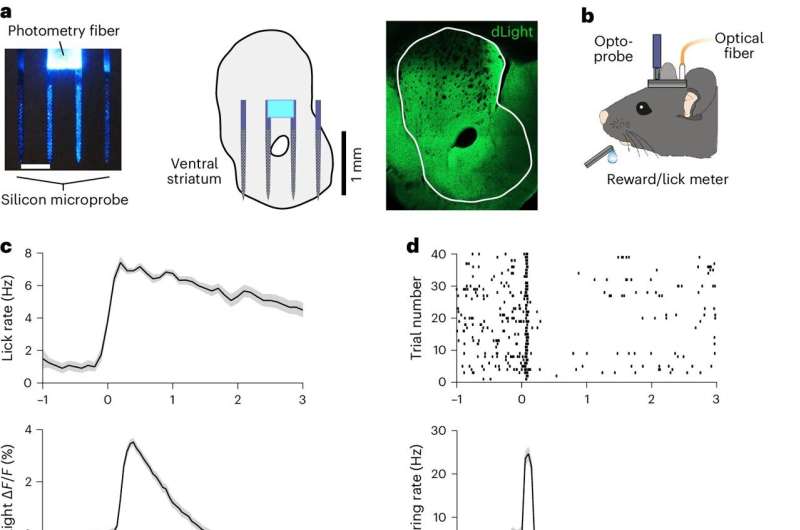This article has been reviewed according to Science X's editorial process and policies. Editors have highlighted the following attributes while ensuring the content's credibility:
fact-checked
peer-reviewed publication
proofread
Dopamine physiology in the brain unveiled through brain engineering

DGIST Department of Brain Sciences Professor Lee Kwang and his team have discovered a new correlation between neural signaling in the brain and dopamine signaling in the striatum. The human brain requires fast neural signal processing in a short period of less than a second.
Dopamine is known to have the strongest effect on brain neural signals, but the research team's newly developed "optical neural chip-based multiple brain signal monitoring technology" shows that changes in dopamine signals within the physiological range do not affect brain neural signal processing.
Dopamine is a chemical neuromodulator that plays an essential role in learning, movement, motivation, and decision-making. It has been linked to a number of diseases, including Parkinson's disease, addiction, and depression.
To analyze the relevance of dopamine signaling to brain neural signal processing and related diseases, DGIST Professor Lee Kwang and his team developed an "optical neural chip-based multiple brain signal monitoring technology" with Professor Masmanidis' team at UCLA. The findings were published online in Nature Neuroscience in July.
The technology can simultaneously record electrical and chemical brain neural signals, and it confirmed that dopamine signaling in the artificially manipulated striatum induces action potential changes in neurons. The findings were validated through machine learning.
The team used optogenetics to simultaneously observe dopamine and neural activity in the "ventral striatum" while controlling the activity of dopamine neurons.
First, when dopamine was not released during neural signal processing in the brain, no abnormalities were found in the activity of the neurons, and when dopamine was released within the normal physiological range (e.g., during food intake), only small or inconsistent changes in the activity of the neurons were observed.
However, when dopamine was artificially released at more than five times the normal physiological range, a significant effect on neural signal processing in the brain was observed.
This suggests that other factors may be more important than dopamine signaling in the brain for certain neural signaling processes, contrary to current theories.
"This study demonstrates for the first time that dopamine signals from food rewards play a minor role in rapidly shaping neural activity in the striatum. This suggests that on a sub-second time scale, neural activity in the striatum may be influenced by other external neural inputs rather than dopamine," said DGIST Professor Lee Kwang.
"We will conduct follow-up studies to illuminate the sophisticated physiology of dopamine in relation to time, including its long-term contribution."
More information: Charltien Long et al, Constraints on the subsecond modulation of striatal dynamics by physiological dopamine signaling, Nature Neuroscience (2024). DOI: 10.1038/s41593-024-01699-z



















